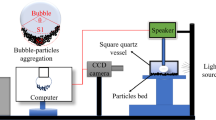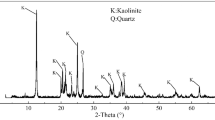Abstract
The surface free energy of mineral particles is a key factor affecting the bubble–particle attachment and mineralization process. In this study, the free surface energy was calculated in order to clarify the interaction mechanism between low-rank coal and dodecyltrimethylammonium chloride (DTAC) from the perspective of thermodynamics. Additionally, wetting heat was employed in order to reveal the change in the surface wettability of long-flame low-rank coal with different DTAC additions, i.e. 0, 15, 30, 45, and 60 g t−1. The wetting heat of long-flame low-rank coal gradually became less negative with the increase in the DTAC dosage, which indicated that the hydrophilicity of the low-rank coal’s surface was effectively restrained, corresponding to enhanced hydrophobicity. Furthermore, the effect of DTAC on the attachment time (induction time) between the coal particles and bubbles was investigated. The results illustrated that the attachment time between the coal particles and the bubbles decreased from 180 to 30 ms as DTAC dosage increased (DTAC dosage of 0–60 g t−1). That is, the attachment time decreased by up to 83.33% over the investigated range of DTAC dosages; this dynamic was consistent with the results of the calculation of the surface free energy and the measurement of the wetting heat. The mean zeta potentials became less negative with the DTAC addition in the presence and absence of diesel oil. Consequently, DTAC enhanced the flotation performance of long-flame low-rank coal in a flotation system; furthermore, the combustible recovery was significantly enhanced (by up to 11.29% points) and the concentrated ash value was less enhanced (by up to 0.20% points) as the DTAC dosage increased up to 60 g t−1.










Similar content being viewed by others
References
Xia WC, Xie GY, Peng YL. Recent advances in beneficiation for low rank coals. Powder Technol. 2015;277:206–21.
Sivrikaya O. Cleaning study of a low-rank lignite with DMS, Reichert spiral and flotation. Fuel. 2014;119:252–8.
Jangam SV, Karthikeyan M, Mujumdar AS. A critical assessment of industrial coal drying technologies: role of energy, emissions, risk and sustainability. Dry Technol. 2011;29:395–407.
Willson WG, Walsh D, Irwin BW. Overview of low-rank coal (LRC) drying. Int J Coal Prep Util. 1997;18:1–15.
Chen SJ, Yang Z, Chen L, Tao XX, Tang LF, He H. Wetting thermodynamics of low rank coal and attachment in flotation. Fuel. 2017;207:214–25.
Wen BF, Xia WC, Sokolovic JM. Recent advances in effective collectors for enhancing the flotation of low rank/oxidized coals. Powder Technol. 2017;319:1–11.
Li YG, Honaker R, Chen JZ, Shen LJ. Effect of particle size on the reverse flotation of subbituminous coal. Powder Technol. 2016;301:323–30.
Xia WC, Yang JG, Zhu B. Flotation of oxidized coal dry-ground with collector. Powder Technol. 2012;228:324–6.
Cinar M. Floatability and desulfurization of a low-rank (Turkish) coal by low-temperature heat treatment. Fuel Process Technol. 2009;90:1300–4.
Lester E, Kingman S. The effect of microwave pre-heating on five different coals. Fuel. 2004;83:1941–7.
Atesok G, Boylu F, Çelik MS. Carrier flotation for desulfurization and deashing of difficult-to-float coals. Miner Eng. 2001;14:661–70.
Liu J, Mak T, Zhou Z, Xu Z. Fundamental study of reactive oily-bubble flotation. Miner Eng. 2002;15:667–76.
Liao YF, Cao YJ, Liu CQ, Zhu GL. A study of kinetics on oily-bubble flotation for a low-rank coal. Int J Coal Prep Util. 2015;36:151–62.
Yekeen N, Manan MA, Idris AK, Samil AM. Influence of surfactant and electrolyte concentrations on surfactant adsorption and foaming characteristics. J Pet Sci Eng. 2017;149:612–22.
Marsalek R, Pospisil J, Taraba B. The influence of temperature on the adsorption of CTAB on coals. Colloids Surf A. 2011;383:80–5.
Dey S. Enhancement in hydrophobicity of low rank coal by surfactants—a critical overview. Fuel Process Technol. 2012;94:151–8.
Qu JZ, Tao XX, He H, Zhang X, Xu N, Zhang B. Synergistic effect of surfactants and a collector on the flotation of a low-rank coal. Int J Coal Prep Util. 2015;35:14–24.
Chander S, Mohal B, Aplan FF. Wetting behavior of coal in the presence of some nonionic surfactants. Colloids Surf. 1987;13:205–16.
Vamvuka D, Agridiotis V. The effect of chemical reagents on lignite flotation. Int J Miner Process. 2001;61:209–24.
Sun SC. Effect of oxidation of coals on their flotation properties. Trans AIME. 1954;6:396–401.
Kelebek S, Demir U, Sahbaz O, Ucar A, Cinar M, Karaguzel C, Oteyaka B. The effects of dodecylamine, kerosene and pH on batch flotation of Turkey’s Tuncbilek coal. Int J Miner Process. 2008;88:65–71.
Liu XY, Liu SY, Fan MQ, Zhao JR. Calorimetric study of the wettability properties of low-rank coal in the presence of CTAB. J Therm Anal Calorim. 2017;130:2025–33.
Sarikaya M, Obzbayoglu G. Flotation characteristics of oxidized coal. Fuel. 1995;74:291–4.
Jańczuk B, Wójcik W, Zdziennicka A, Bruque JM. Components of the surface free energy of low rank coals in the presence of n-alkanes. Powder Technol. 1996;86:229–38.
Zou WJ, Cao YJ, Liu JT, Li WN, Liu C. Wetting process and surface free energy components of two fine liberated middling bituminous coals and their flotation behaviors. Powder Technol. 2013;246:669–76.
Ali SSM, Heng JYY, Nikolaev AA, Waters KE. Introducing inverse gas chromatography as a method of determining the surface heterogeneity of minerals for flotation. Powder Technol. 2013;249:373–7.
Gu GX, Xu ZH, Nandakumar K, Masliyah J. Effects of physical environment on induction time of air-bitumen attachment. Int J Miner Process. 2003;69:235–50.
Chen SJ, Tang LF, Tao XX, He H, Chen L, Yang Z. Enhancing flotation performance of low rank coal by improving its hydrophobicity and the property of oily bubbles using 2-ethylhexanol. Int J Miner Process. 2017;167:61–7.
Van-Oss CJ, Giese RF. The hydrophilicity and hydrophobicity of clay minerals. Clays Clay Miner. 1995;43:474–7.
Siebold A, Walliser A, Nardin M, Oppligerb M, Schultz J. Capillary rise for thermodynamic characterization of solid particle surface. J Colloid Interface Sci. 1997;186:60–70.
Thomas JK, Gunda K, Rehbein P, Ng FTT. Flow calorimetry and adsorption study of dibenzothiophene, quinoline and naphthalene overmodified Y zeolites. Appl Catal B. 2010;94:225–33.
Chen SJ, Wang SW, Li LL, Qu JZ, Tao XX, He H. Exploration on the mechanism of enhancing low-rank coal flotation with cationic surfactant in the presence of oily collector. Fuel. 2018;227:190–8.
Norori-Mccormac A, Brito-Parada PR, Hadler K, Cole K, Cilliers JJ. The effect of particle size distribution on froth stability in flotation. Sep Purif Technol. 2017;184:240–7.
Ye Y, Khandrika SM, Miller JD. Induction-time measurements at a particle bed. Int J Miner Process. 1989;25:221–40.
Xia WC, Zhou CL, Peng YL. Enhancing flotation cleaning of intruded coal dry-ground with heavy oil. J Clean Prod. 2017;161:591–7.
Ralston J, Fornasiero D, Hayes R. Bubble-particle attachment and detachment in flotation. Int J Miner Process. 1999;56:133–64.
Liu XY, Liu SY, Fan MQ, Zhang L. Decrease of hydrophilicity of lignite using CTAB: effects of adsorption differences of surfactant onto mineral composition and functional groups. Fuel. 2017;197:474–81.
Bustamante H, Woods G. Interaction of dodecylamine and sodium dodecyl sulphate with a low-rank bituminous coal. Colloids Surf. 1984;12:381–99.
Wang SW, Tao XX. Combination of viscosity regulator and frother to enhance lowrank coal flotation performance. Sep Sci Technol. 2017;52:2463–72.
Stonestreet P, Franzidis JP. Reverse flotation of coal—a novel way for the beneficiation of coal fines. Miner Eng. 1988;1:343–9.
Acknowledgements
The authors would like to acknowledge financial support from the Fundamental Research Funds for the National Natural Science Foundation of China (No. 51722405) and the Project Funded by the Priority Academic Program Development of Jiangsu Higher Education Institutions (PAPD).
Author information
Authors and Affiliations
Corresponding author
Additional information
Publisher's Note
Springer Nature remains neutral with regard to jurisdictional claims in published maps and institutional affiliations.
Rights and permissions
About this article
Cite this article
Zhen, K., Zhang, H. & Zheng, C. Wettability modification and flotation intensification of low-rank coal with dodecyltrimethylammonium chloride addition. J Therm Anal Calorim 137, 2007–2016 (2019). https://doi.org/10.1007/s10973-019-08131-w
Received:
Accepted:
Published:
Issue Date:
DOI: https://doi.org/10.1007/s10973-019-08131-w




